5.3 Drainage below ground
SCOPE
DESIGN STANDARDS
Design that follows the guidance below will be acceptable for drainage below ground.
STATUTORY REQUIREMENTS
Design should be in accordance with relevant Building Regulations and other statutory requirements.
All drainage schemes require the approval of the Building Control Authority. Local sewerage undertakers may impose additional requirements and restrictions. Both should be consulted early, especially where the drainage system is to be adopted under an agreement under Section 104 of the Water Industry Act 1991 or Sewerage (Scotland) Act 1968. The system may need to be inspected and tested by the sewerage undertaker, as well as by the Local Authority, Building Control Authority and NHBC.
Sewers which are to be adopted under an agreement under Section 104 of the Water Industry Act 1991 or Sewerage (Scotland) Act 1968 are outside the scope of this document. For information on standards required for adopted sewers, contact the local sewerage undertaker and other relevant Authorities.
Satisfactory outfall disposal is essential where a septic tank is installed. In England and Wales the Environment Agency consent may be needed to discharge effluent from a septic tank. In Northern Ireland the Department of the Environment should approve proposals, in Scotland the Local Authority and, where appropriate, the River Purification Authority should approve proposals.
Ground conditions may preclude the use of septic tanks in some locations. In all cases NHBC will require evidence of a satisfactory percolation test where a septic tank drainage system is being installed. See Appendix 5.3-B.
For surface water discharge into a watercourse the permission of the Environment Agency is required in England and Wales. A "consent to discharge" is required from the DoE in Northern Ireland. In Scotland the Local Authority and, where appropriate, the River Purification Authorities should be consulted.
DRAINAGE SYSTEM DESIGN
Items to be taken into account include:
Guidance on drainage design is given in BS EN 752.
The drainage system should be designed to be compatible with the main sewerage system:
- as a combined system, or
- with separate systems for foul water and surface water, or
- with separate systems where foul water is connected to the main sewer, while surface water disposal is by soakaways or other suitable means.
Where the sewerage undertaker permits surface water drains to be connected to a foul water system an interceptor should be installed on the surface water side of the foul sewer junction, or trapped gullies should be used.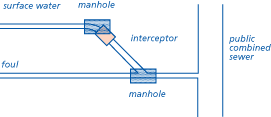
Where ground water drains are connected to surface water drains, there should be a silt trap on the ground water side of the junction.
Ensure that a legal right exists when connecting drains to an outfall.
Private drainage systems should be sufficient to cope with the intended capacity. The design should be in accordance with BS EN 752 or similar authoritative document.
Where an existing private drainage system is to be extended, or where the capacity is to be increased, sufficient investigation, measurement and calculation should be undertaken to ensure that all parts of the private system are of adequate capacity.
Items to be taken into account include:
Ventilation of drains is normally achieved by ventilating discharge stacks. For details, reference should be made to Chapter 8.1 'Internal services' (Design).
Air admittance valves which have been assessed in accordance with Technical Requirement R3 may be used in some dwellings to prevent trap seal siphonage. An open vent is generally required at the head of common drainage systems and where the discharge pipe is the only vent for a septic tank or cesspool.
RADON
In certain geographical locations special precautions may be necessary to reduce the entry of radon gas, for example where drains enter buildings. Areas in England where special precautions are necessary are detailed in BRE Report 211.
LANDFILL AND OTHER GASES
Precautions to be taken when building where landfill or other gases may be present are given in BRE Report 212.
Where necessary ensure that drains are sealed where they enter the building.
Septic tanks and cesspools should be at least 7m from a dwelling and within 30m of a vehicular access to permit emptying. In Scotland they should be at least 5m from a dwelling and a boundary.
Where a gravity system is not possible, pumps may have to be used. Pumped systems should be designed in accordance with BS EN 752 and BS 6297. The installation should include:
- holding tank of sufficient volume to contain 24 hours domestic effluent based on 120L/150L per head per day
- suitable warning system giving visual and/or audible signals to indicate system malfunction
- suitable equipment housing.
Items to be taken into account include:
Pipe sizes should be designed for the maximum peak load, using BS EN 752 as the basis for calculations. Ground water drains and soakaways should be designed with sufficient capacity for normal weather conditions.
Design gradients should be as even as practicable, depending on the number of WCs being served (minimum one for 100mm pipes, five for 150mm pipes, with peak flows greater than 1 L/sec. at the gradients shown below).
Where flows are 1.0 L/second or less, gradients for 100mm diameter pipes should not be flatter than 1:40.
The following gradients may be used where flows exceed 1.0L/second:
| Pipe diameter [mm] | Minimum gradient |
| 100 | 1 : 80 |
| 150 | 1 : 150 |
Pipe runs should be designed to maintain self-cleansing velocity (0.7 m/s). They should be as straight as practicable with minimal changes of direction. Bends should only occur in or next to inspection chambers or manholes. Curves should be slight so that blocked pipes can be cleared.
To ensure that every length of drain can be rodded, the design should include all necessary access points, such as:
- rodding eyes
- access chambers
- inspection chambers
- manholes.
Sizes of access fittings and chambers should be specified for the depth of invert as detailed in Appendix 5.3-A.
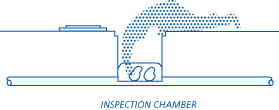
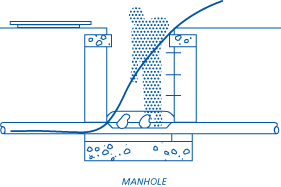
Inspection chambers and manholes may be the following types:
- open, half-round section channel with suitable benching, or
- closed access - at manholes, cover panels have to be removed to gain access to the pipe.
Side branches to inspection chambers and manholes should discharge into the main channel not higher than half pipe level.
Connections should be made obliquely in the direction of flow.

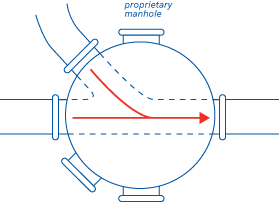
For construction details of access fittings and chambers, reference should be made to clause S6.
Items to be taken into account include:
All pipes should have flexible joints.
Where ground movement may occur, precautions against leakage are needed. In mining areas, and in other locations where movement could be significant, a flexible pipe system should be specified. Flexible systems should be flexible pipes with flexible joints. Refer to Sitework Clause S5.
Proper allowance should be made for settlement. Where there is a risk of soil movement, for example in made-up ground, design gradients should be steeper than the minimum allowed for the flow rate and pipe size.
In non-uniform or saturated soils where movements of the trench bottom can be expected, soft spots should be removed and replaced with suitable material. Protective blinding should be specified for the trench bottom, to be placed immediately following excavation.
In ground conditions where movement is likely to adversely affect the drain a support system for the drain should be designed by an Engineer in accordance with Technical Requirement R5.
Shrinkage and heave of clay soils can affect pipelines. Design gradients should be greater than the permitted minimum to allow for possible movement. Refer to Chapter 4.2 'Building near trees' for details of zones of influence of trees.
Where there is a risk of flooding the advice of the relevant Rivers Authority should be followed.
Foul and surface water drainage systems should prevent the ingress of ground water.
DESIGN TO AVOID DAMAGE
Items to be taken into account include:
Drains should be located so that foundation loads are not transmitted to pipes. Where drainage trenches are near foundations, foundation depths should be increased or the drain re-routed further from the foundations.
Where the bottom of a trench is below foundation level, the trench should be filled with concrete to a suitable level.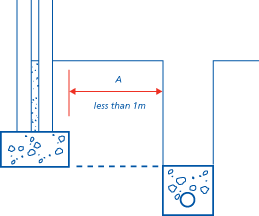
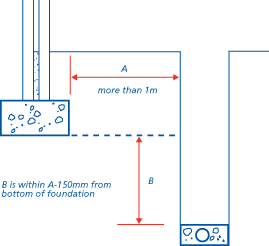
Where drains pass through structural elements, allowance should be made for differential movement, thermal movement and maintenance.
Pipes passing through substructure walls should accommodate movement by:
- 50mm clearance all round, or
- a sleeve with a 50mm clearance, or
- if built in, a connection on both sides of the wall to pipes with flexible joints located not more than 150mm from the face of the wall. Refer to Sitework clause S5(a).
See clause D4(b) for prevention of gas entering the building.
Pipes should be firmly supported throughout their length and bedded to resist loads from overlying fill and traffic.
Small diameter rigid pipes may be laid:
- directly on trench bottoms, or
- bedded on granular material. Refer to Sitework clause S4.
For flexible pipes, and where a greater factor of safety is needed, specify the bedding class and grading of backfill as described in BS EN 13242, BS 5955 and BS EN 752. Refer to Sitework clause S4(a).
When using proprietary systems assessed in accordance with Technical Requirement R3, pipes should be supported in accordance with the assessment.
Special protection may be required where pipes are near the ground surface or where they could be damaged by the weight of backfill or traffic load from above. Guidance is given in Sitework clause S5 and in BS 5955 and BS EN 752.
Manhole covers, gully gratings and other fittings should be suitable for the traffic conditions.
If the ground or ground water contains sulfates, concrete and masonry work may require special precautions as detailed in Chapters 2.1 'Concrete and its reinforcement' (Design) and 6.1 'External masonry walls' (Design).
FOUL AND SURFACE WATER DISPOSAL
Items to be taken into account include:
All connections to a public sewer will require the agreement of the responsible authority. They should be consulted as to the type and position of the connection to be made.
All connections to a private sewer will require the agreement of the owners of the sewer. This should be obtained as part of the design process. If the main private sewer discharges into a public sewer the local sewerage undertaker should be notified of the proposal.
The entry flow velocity should be restricted to reduce disturbance in the tank. For drains not exceeding 150mm diameter a gradient not steeper than 1:50 for a distance of at least 12m upstream of the entry is required.
Rodding and cleaning facilities should be provided at the connection with the tank.
Surface water drainage is generally required to be separated from foul water drainage. Surface water may be discharged into public surface water main drains or directly into natural watercourses, ponds or soakaways, as appropriate. Surface water should not discharge to a septic tank or cesspool, or a separate foul sewer.
For large or complicated dwellings the amount of surface water to be disposed of may be calculated by reference to BS 6367.
Siting of soakaways should take account of topography to ensure that water is drained away from the building. In soil of low permeability, soakaways should only be provided where no alternative system is available. Soakaways should be a minimum of 5m from any adjacent building.
A simple test for assessing the permeability of the soil and how to convert the result into soakaway dimensions is detailed in Appendix 5.3-E. A more refined method to determine soakaway size is given in BRE Digest 365.
A cesspool is a tank which stores effluent and has to be emptied periodically.
Cesspools should be sited within 30m of a vehicle access to permit emptying. They should be at least 7m from a dwelling.
Cesspools are required to be at least 18m3 capacity. A 45 day holding capacity calculated at 150 litres/head/day should be provided.
A septic tank is a form of treatment plant and requires a suitable outfall (agreed by the relevant authority) for treated effluent discharge. Septic tank design is detailed in BS 6297.
Septic tanks should be sited within 30m of a vehicle access to permit emptying. They should be at least 7m from a dwelling. In Scotland they should be at least 5m from a dwelling and a boundary.
CAPACITY
The capacity of the septic tank should be based on the number of people it will serve. This is determined by the formula:
C = 180P + 2000
where C = capacity of tank (in litres) min 2700L
and
P = design population/potential occupancy (min 4)
Appendix 5.3-C gives minimum capacities for septic tanks serving up to 10 persons.
OUTFALL
The outfall from a septic tank may require consent from the Environment Agency in England and Wales. In Northern Ireland the Environment and Heritage Service should approve proposals. In Scotland the Scottish Environment Protection Agency should approve proposals. The designer should ensure at an early stage that consent will be given, or an alternative method of drainage selected.
Copies of relevant consents are required by NHBC before work commences.
POROUS SUBSOILS
If the outfall from a septic tank is to discharge to a porous subsoil, such as gravel, sand or chalk, at a level above that of the winter water table level, a soakaway may be used.
This consists of an excavation filled with brick bats or other large pieces of inert material; or unfilled but lined, eg with dry laid brickwork or precast concrete (porous or perforated) rings, from which the effluent may percolate into the surrounding ground. Soakaways which are not filled should be covered by a slab incorporating an inspection cover.
The size of the soakaway should be determined as described in Appendix 5.3-C, the area of the bottom of the soakaway should equal the area of trench bottom in Chart 1.
Where the porous strata is overlaid by less permeable sub soil a bore hole may be permitted by the appropriate authority.
Proprietary septic tanks should be assessed in accordance with Technical Requirement R3.
LESS POROUS SUBSOILS
In less porous subsoils a sub surface irrigation system may be a possible alternative.
Such an alternative will have to be designed to determine the area of the sub surface drainage trench from which the length of land drain can be found.
First a percolation test has to be carried out to determine the percolation value (s) in seconds. Details of how to carry out the test are given in Appendix 5.3-B.
If the percolation value is less than 100s use Chart 1 to determine the field drain trench area and Chart 2 the pipe length to provide this area. For percolation values between 100s and 140s underdrains are necessary. For percolation values in excess of 140s the soil is unsuitable for field drains.
Design guidance for underdrains is given in Appendix 5.3-D.
FIELD DRAINS
These should be:
- sited taking account of topography to ensure that water is drained away from the building
- perforated pipes laid at least 500mm below the surface
- laid in trenches with a uniform gradient not steeper than 1:200 with undisturbed ground 2m wide between trenches and at least 8m from any building and 10m from any water course
- laid on a 150mm bed of clinker, clean gravel or broken stone (20 - 50mm grade) and the trenches filled to a level 50mm above the pipe and covered with strips of plastic material to prevent entry of silt
- backfilled with as dug material.
Note. If the level of the water table is expected to rise in the winter months to within 1m of the invert of the field drains, it is not acceptable to use sub-surface irrigation.
Small sewage treatment works for more than one dwelling should be designed in accordance with BS 6297. The discharge from the waste water treatment plant should be sited at least 10m away from water courses and dwellings. The design should be carried out by a suitably qualified engineer.
GROUND WATER DRAINAGE
Depending on site contours and ground conditions, ground water drainage, where required, may be designed as a:
- natural system
- herringbone system
- grid system
- fan-shaped system
- moat system.
Pipe perforations should be holes or slots to suit the nature of the ground.
Ground water drain systems connected to foul, surface water or combined drains should discharge into the drain through a catchpit. Where available, ground water drainage may discharge into a soakaway, preferably through a catchpit or into a watercourse.
In England and Wales the National Rivers Authority consent may be needed for discharge proposals. In Northern Ireland the Department of Environment should approve proposals; in Scotland the River Purification Authority should approve proposals.
PROVISION OF INFORMATION
Drawings and specifications should include:
- proposed drain layout
- invert levels and locations of existing sewers
- junctions
- ground floor levels of dwellings
- external finished levels
- inspection and access points
- method of disposal of both foul and surface water
- position of any septic tank or cesspool in relation to adjacent buildings
- results of percolation tests where treated effluent disposal is through field drains
- length of field drains and their layout (including details of trench width, this being critical to the functioning of the system)
- depth of field drains.
Drains or sewers which are intended for adoption should be clearly identified on relevant drawings.
Ensure that design and specification information is distributed to site supervisors, relevant specialist subcontractors and/or suppliers.





















